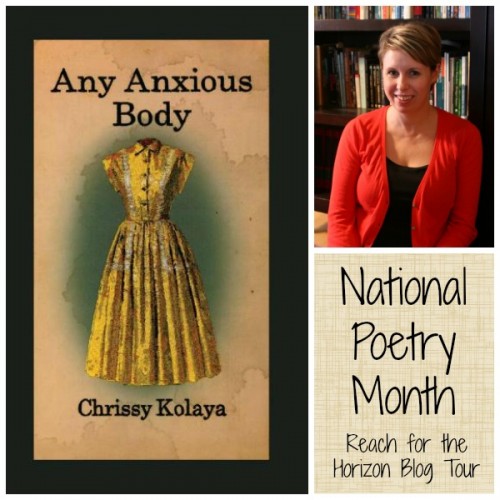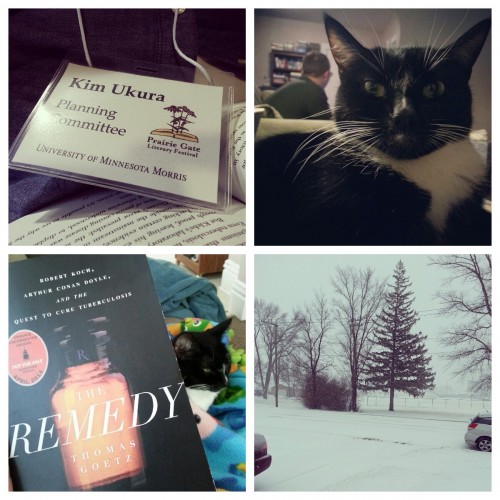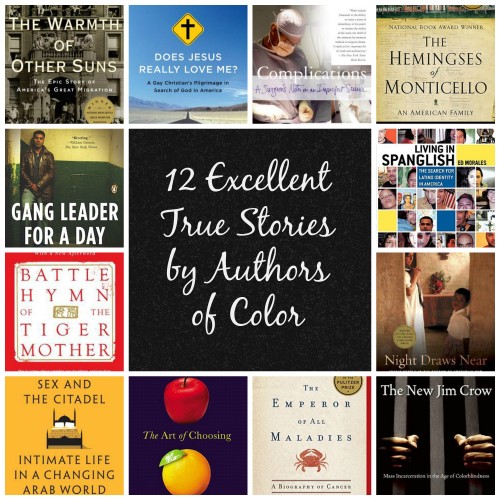
Today I am excited to invite poet Chrissy Kolaya, a a good friend of mine, to the blog to help celebrate National Poetry Month. Chrissy is one of the local people that I get to completely nerd out about books with, and I love hearing her perspective on issues in publishing from her perspective as an author.
Last month, Chrissy published her first book of poetry, Any Anxious Body. To celebrate that accomplishment, I invited her to the blog as part of the National Poetry Month: Reach for the Horizon Blog Tour that Serena at Savvy Verse and Wit was wonderful enough to organize again. Make sure you check out the other posts this month and I hope you enjoy this Q&A!
What was the process for getting this book published? What has your experience been working with a small publishing house?
Publishing any kind of creative work is difficult these days. I sent this manuscript around to poetry presses and first book contests for seven years before it found a home. In the end, though, the publisher who liked the book, Broadstone Books, has turned out to be a dream-come-true to work with. Their editorial suggestions were spot on (I sometimes felt like my editor understood the book better than I did!), and, breaking with conventional publishing wisdom, they allowed me to be part of the cover design process, which meant that I ended up with a gorgeous cover image by a friend and colleague, Jess Larson.
Some of the poems are inspired by notes from your great grandmother and a letter from her daughter, your grandmother. How did you find these, and what inspired you to use them in this book?
I built the book around these two sets of notes. The first were really not much more than scribbles my great-grandmother made while in the hospital dying, communicating with her family, after she could no longer speak, on a small pad of paper that included at the end (in someone else’s handwriting) a list of the expenses for her funeral and her assets, all of which comes to a shortage of “$34.50” for each of her four children. Her own final note reads:
“we
will never
pay for this”
The other inspiration is a long letter left behind by my grandmother, an attempt at explaining her life to her children, which captures her voice, her interior life, and her daily reality:
“then
finally
we had money to eat good”
My mother shared a copy of my grandmother’s letter with me years ago. We found the notes from my great grandmother while digging through an old suitcase full of family photos.
Both my grandmother and great-grandmother died long before I could get to know them, and as I thought about these women, I considered the difference between their educations and mine, between their work and life opportunities and mine, their voices and use of language, their struggles, the emotional experiences of their lives, and how I wouldn’t have had access to any of these interior lives if it hadn’t been for the accident in one case and the deliberate act in another of their words left behind.
I think it’s so important to remember that the recording of life stories is the privilege of those with the time and financial circumstances to do so, something neither of these women possessed, so I wanted to preserve and treasure these small pieces of poetry and narrative they both left behind as a record of their lives.
In addition to writing poetry and novels, you are creative writing professor at a small liberal arts college, wife and mother of two (awesome) boys. How do you make time for your writing among those other responsibilities?
For me, what has worked is figuring out the kind of work I can get done in the time I have available. I’ve come to realize how valuable a spare 15 minutes can be! During the school year, I read for research, revise work, and attend to the “business” of writing—sending work out, applying for grants, etc. During the summers, when I’m not teaching a summer course, there’s more time to sink deeply into a big project.
What is the best piece of advice you have for aspiring writers?
I actually have two: be tenacious and be kind. Regarding tenacity, I like to share with my students the story of my most well-published story, one that Crazyhorse picked up and that made its way from there into an anthology called New Sudden Fiction. That story, though it eventually found two fantastic homes that brought it to the attention of more readers than I ever imagined, was rejected 15 times. I share this with students not to discourage them, but to give them an idea of the kind of tough skin you have to develop as a writer sending your work out into the world.
Regarding kindness, novelist Sandra Benitez once gave me and a group of writers some fantastically simple advice—just be a nice person. It’s pretty good advice for life in general, but especially in a field that can be so full of frustration and heartbreak. I’m teaching this semester from an outstanding Lance Olson book called Architectures of Possibility, and in it, he reminds us that just as important as the work we make is the work we support as, what he calls, “literary activists.” I love this idea of being aware of the many small ways we can support one another, and I can’t count the number of times I’ve been bowled over by the kindness and generosity of other writers.
What are you reading right now?
This is perhaps connected to your earlier question about time, but for a long while there, I was finding it difficult to find time for pleasure reading, until I realized I could listen to books while doing housework—folding laundry, making dinner, etc. So most of my pleasure reading these days is via audiobook, and the one I’m most excited about lately is Long Division by Kiese Laymon. I’m also reading for research on a novel project I’m working on, which has my desk piled high with a bunch of encyclopedias of cryptozoology and the memoir of Darwin’s granddaughter.






